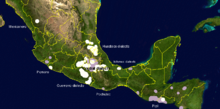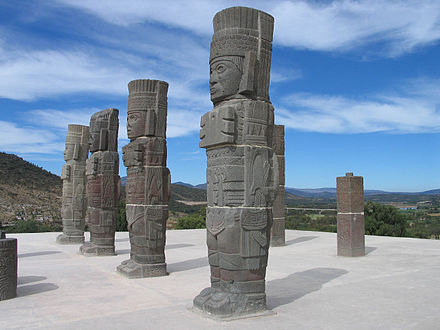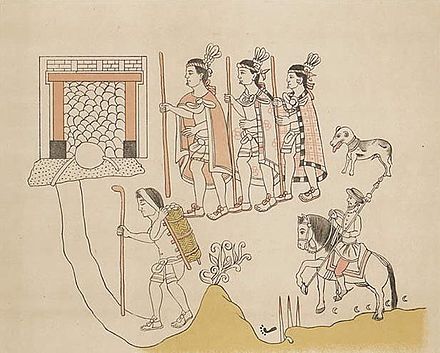The Nahuas (/ˈnɑːwɑːz/ NAH-wahz[1]) are one of the Indigenous people of Mexico, with Nahua minorities also in El Salvador, Guatemala, Honduras, Nicaragua, and Costa Rica.[2][3][4][5][6][7] They comprise the largest indigenous group in Mexico.[8][9] They are a Mesoamerican ethnicity. The Mexica (Aztecs) are of Nahua ethnicity, as are their historical enemies, the Tlaxcallans (Tlaxcaltecs). The Toltecs which predated both groups are often thought to have been Nahua as well. However, in the pre-Columbian period Nahuas were subdivided into many groups that did not necessarily share a common identity.
Their Nahuan languages, or Nahuatl, consist of many variants, several of which are mutually unintelligible. About 1.5 million Nahuas speak Nahuatl and another million speak only Spanish. Fewer than 1,000 native speakers of Nahuatl remain in El Salvador.[10]
It is suggested that the Nahua peoples originated near Aridoamerica, in regions of the present day Mexican states of Durango and Nayarit or the Bajío region. They split off from the other Uto-Aztecan speaking peoples and migrated into central Mexico around 500 CE. The Nahua then settled in and around the Basin of Mexico and spread out to become the dominant people in central Mexico. However, Nahuatl-speaking populations were present in smaller populations throughout Mesoamerica.
The name Nahua is derived from the Nahuatl word-root nāhua- [ˈnaːwa-],[11] which generally means "audible, intelligible, clear" with different derivations including "language" (hence nāhuat(i) [ˈnaːwat(i)] "to speak clearly" and nāhuatl [ˈnaːwat͡ɬ] both "something that makes an agreeble sound" and "someone who speaks well or speak one's own language").[12] It was used in contrast with popoloca [popoˈloka], "to speak unintelligibly" or "speak a foreign language".[13] Another, related term is Nāhuatlācatl [naːwaˈt͡ɬaːkat͡ɬ] (singular) or Nāhuatlācah [naːwaˈt͡ɬaːkaʔ] (plural) literally "Nahuatl-speaking people".[12]
The Nahuas are also sometimes referred to as Aztecs. Using this term for the Nahuas has generally fallen out of favor in scholarship, though it is still used for the Aztec Empire. They have also been called Mēxihcatl [meːˈʃiʔkat͡ɬ] (singular), Mēxihcah [meːˈʃiʔkaʔ] (plural)[14] or in Spanish Mexicano(s) [mexiˈkano(s)] "Mexicans", after the Mexica, the Nahua tribe which founded the Aztec Empire.


At the turn of the 16th century, Nahua populations occupied territories ranging across Mesoamerica as far south as Panama.[15] However, their core area was Central Mexico, including the Valley of Mexico, the Toluca Valley, the eastern half of the Balsas River basin, and modern-day Tlaxcala and most of Puebla, although other linguistic and ethnic groups lived in these areas as well. They were also present in large numbers in El Salvador, Nicaragua, southeastern Veracruz, and Colima and coastal Michoacan.[16] Classical Nahuatl was a lingua franca in Central Mexico before the Spanish conquest due to Aztec hegemony,[17] and its role was not only preserved but expanded in the initial stage of colonial rule, encouraged by the Spaniards as a literary language and tool to convert diverse Mesoamerican peoples. There are many Nahuatl place names in regions where Nahuas were not the most populous group (including the names of Guatemala and several Mexican states), due to Aztec expansion, Spanish invasions in which Tlaxcaltecs served as the main force, and the usage of Nahuatl as a lingua franca.
The last of the southern Nahua populations today are the Pipil of El Salvador and the Nicarao of Nicaragua.[18] Nahua populations in Mexico are centered in the middle of the country, with most speakers in the states of Puebla, Veracruz, Hidalgo, Guerrero and San Luis Potosí. However, smaller populations are spread throughout the country due to recent population movements within Mexico. Within the last 50 years, Nahua populations have appeared in the United States, particularly in New York City, Los Angeles, and Houston.[19]

Archaeological, historical and linguistic evidence suggest that the Nahuas originally came from the deserts of northern Mexico (Aridoamerica) and migrated into central Mexico in several waves.[20] The presence of the Mexicanero people (who speak a Nahuatl variant) in this area until the present day affirms this theory. Before the Nahuas entered Mesoamerica, they were probably living for a while in northwestern Mexico alongside the Cora and Huichol peoples.[21] The first group of Nahuas to split from the main group were the Pochutec who went on to settle on the Pacific coast of Oaxaca possibly as early as 400 CE.[22] From c. 600 CE the Nahua quickly rose to power in central Mexico and expanded into areas earlier occupied by Oto-Manguean, Totonacan and Huastec peoples.[23] Through their integration in the Mesoamerican cultural area the Nahuas adopted many cultural traits including maize agriculture and urbanism, religious practices including a ritual calendar of 260 days and the practice of human sacrifices and the construction of monumental architecture and the use of logographic writing.

Around 1000 CE the Toltec people, normally assumed to have been of Nahua ethnicity, established dominion over much of central Mexico which they ruled from Tollan Xicocotitlan.[24]
From this period on the Nahua were the dominant ethnic group in the Valley of Mexico and far beyond, and migrations kept coming in from the north. After the fall of the Toltecs a period of large population movements followed and some Nahua groups such as the Pipil and Nicarao arrived as far south as northwestern Costa Rica.[25][26][27][28] And in central Mexico different Nahua groups based in their different "Altepetl" city-states fought for political dominance. The Xochimilca, based in Xochimilco ruled an area south of Lake Texcoco; the Tepanecs ruled the area to the west and the Acolhua ruled an area to the east of the valley. One of the last of the Nahua migrations to arrive in the valley settled on an island in the Lake Texcoco and proceeded to subjugate the surrounding tribes. This group were the Mexica who during the next 300 years became the dominant ethnic group of Mesoamerica ruling from Tenochtitlan their island capital. They formed the Aztec Empire after allying with the Tepanecs and Acolhua people of Texcoco, spreading the political and linguistic influence of the Nahuas well into Central America.

In 1519 an expedition of Spaniards sailing from Cuba under the leadership of Hernán Cortés arrived on the Mexican gulf coast near the Totonac city of Quiyahuiztlan. The Totonacs were one of the peoples that were politically subjugated by the Aztecs and word was immediately sent to the Aztec Emperor (in Nahuatl, Tlatoani) of Tenochtitlan Motecuhzoma II. Going inland the Spaniards encountered and fought with Totonac forces and Nahua forces from the independent Altepetl of Tlaxcallan. The Tlaxcaltecs were a Nahua group who had avoided being subjugated by the Aztecs. After being defeated in battle by the Spaniards, the Tlaxcalans entered into an alliance with Cortes that would be invaluable in the struggle against the Aztecs.[29] The Spanish and Tlaxcaltec forces marched upon several cities that were under Aztec dominion and "liberated" them, before they arrived in the Aztec capital of Tenochtitlan. There they were welcomed as guests by Motecuhzoma II, but after a while they took the ruler prisoner. When the Aztec nobility realized that their ruler had been turned into a Spanish puppet they attacked the Spaniards and chased them out of the city. The Spaniards sought refuge in Tlaxcala where they regrouped and awaited reinforcements. During the next year they cooperated with large Tlaxcaltec armies and undertook a siege campaign resulting in the final fall of Tenochtitlan. After the fall of Tenochtitlan Spanish forces now also allied with the Aztecs to incorporate all the previous Aztec provinces into the realm of New Spain. New Spain was founded as a state under Spanish rule but where Nahua people were recognized as allies of the rulers and as such were granted privileges and a degree of independence that other indigenous peoples of the area did not enjoy. Recently historians such as Stephanie Wood and Matthew Restall have argued that the Nahua did not experience the conquest as something substantially different from the sort of ethnic conflicts that they were used to, and that in fact they may have at first interpreted it as a defeat of one Nahua group by another.[30]
With the arrival of the Spanish in Mesoamerica a new political situation ensued. The period has been extensively studied by historians, with Charles Gibson publishing a classic monograph entitled The Aztecs Under Spanish Rule.[31] Historian James Lockhart built on that work, publishing The Nahuas After the Conquest in 1992. He divides the colonial history of the Nahua into three stages largely based on linguistic evidence in local-level Nahuatl sources, which he posits are an index of the degree of interaction between Spaniards and Nahuas and changes in Nahua culture.[32] An overview of the Nahuas of colonial Central Mexico can be found in the Cambridge History of the Native Peoples of the Americas.[33]

The early period saw the first stages of the establishment of churches by mendicant friars in large and important Indian towns, the assertion of crown control over New Spain by the high court (Audiencia) and then the establishment of the viceroyalty, and the heyday of conqueror power over the indigenous via the encomienda. In the initial stage of the colonial period, contact between Spaniards and the indigenous populations was limited. It consisted mostly in the mendicants who sought to convert the population to Catholicism, and the reorganization of the indigenous tributary system to benefit individual Spaniards. The indigenous system of smaller settlements' paying tribute and rendering labor service to dominant political entities was transformed into the Encomienda system. Indigenous of particular towns paid tribute to a Spanish encomendero who was awarded the labor and tribute of that town.[34][35] In this early period, the hereditary indigenous ruler or tlatoani and noblemen continued to hold power locally and were key to mobilizing tribute and labor for encomenderos. They also continued to hold titles from the pre-conquest period. Most willing accepted baptism so that records for this period show Nahua elites with Christian given names (indicating baptism) and many holding the Spanish noble title don. A set of censuses in alphabetic Nahuatl for the Cuernavaca region c. 1535 gives us a baseline for the impact of Spanish on Nahuatl, showing few Spanish loanwords taken into Nahuatl.[36]
As the Spaniards sought to extend their political dominance into the most remote corners of Mesoamerica, the Nahua accompanied them as auxiliaries. In the early colonial period, new Nahua settlements were made in northern Mexico and far south into Central America. Nahua forces often formed the bulk of the Spanish military expeditions that conquered other Mesoamerican peoples, such as the Maya, Zapotecs, and Mixtecs.
With the arrival of Christian missionaries, the first priority of the colonial authorities was eradicating indigenous religious practices, something they achieved by a combination of violence and threats of violence, and patient education. Nahua were baptized with Spanish names. The Nahua who did not abandon their religious practices were severely punished or executed. The Nahua, however, often incorporated pre-Christian practices and beliefs into the Christian religion without the authorities' noticing it. Often they kept practicing their own religion in the privacy of their homes, especially in rural areas where Spanish presence was almost completely lacking and the conversion process was slow.
The Nahua quickly took the Latin alphabetic writing as their own. Within 20 years of the arrival of the Spanish, the Nahua were composing texts in their own language. In 1536 the first university of the Americas, the Colegio de Santa Cruz de Tlatelolco was inaugurated. It was established by the Franciscans whose aim was to educate young Nahua noblemen to be Catholic priests who were trilingual: literate in Spanish, Latin and Nahuatl.[37]
There are a large number of texts by and about Nahuas in this middle period and during this period Nahuatl absorbed a large number of loanwords from Spanish, particularly nouns for particular objects, indicating the closer contact between the European sphere and the indigenous. However, Nahuatl verbs and syntax show no evidence of the impact of Spanish contact.[38] In the mid-sixteenth century, cultural change at the local level can be tracked through the production of Nahuatl alphabetic texts. The production of a wide range of written documents in Nahuatl dates from this period, including legal documents for transactions (bills of sale), minutes of indigenous town council (cabildo) records, petitions to the crown, and others.
Institutionally, indigenous town government shifted from the rule of the tlatoani and noblemen to the establishment of Spanish-style town councils (cabildos), with officers holding standard Spanish titles. A classic study of sixteenth-century Tlaxcala, the main ally of the Spaniards in the conquest of the Mexica, shows that much of the prehispanic structure continued into the colonial period.[39] An important set of cabildo records in Nahuatl for Tlaxcala is extant and shows how local government functioned in for nearly a century.[40]
Regarding religion, by the mid- to late 16th century, even the most zealous mendicants of the first generation doubted the capacity of Nahua men to become Christian priests so that the Colegio de Santa Cruz de Tlatelolco ceased to function to that end and in 1555 Indians were barred from ordination to the priesthood. However, in local communities, stone-built church complexes continued to be built and elaborated, with murals in mixed indigenous-Spanish forms.[41] Confraternities (cofradías) were established to support the celebrations of a particular Christian saint and functioned as bu